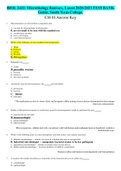Exam (elaborations)
BIOL 2421: Microbiology final ocx, Latest 2020/2021 TEST BANK
- Course
- Institution
BIOL 2421: Microbiology final ocx, Latest 2020/2021 TEST BANK Guide, South Texas College. CH-01Answer Key 1. Microorganisms are best defined as organisms that A. can only be found growing in laboratories. B. are too small to be seen with the unaided eye. C. are infectious particles. D. lack...
[Show more]



